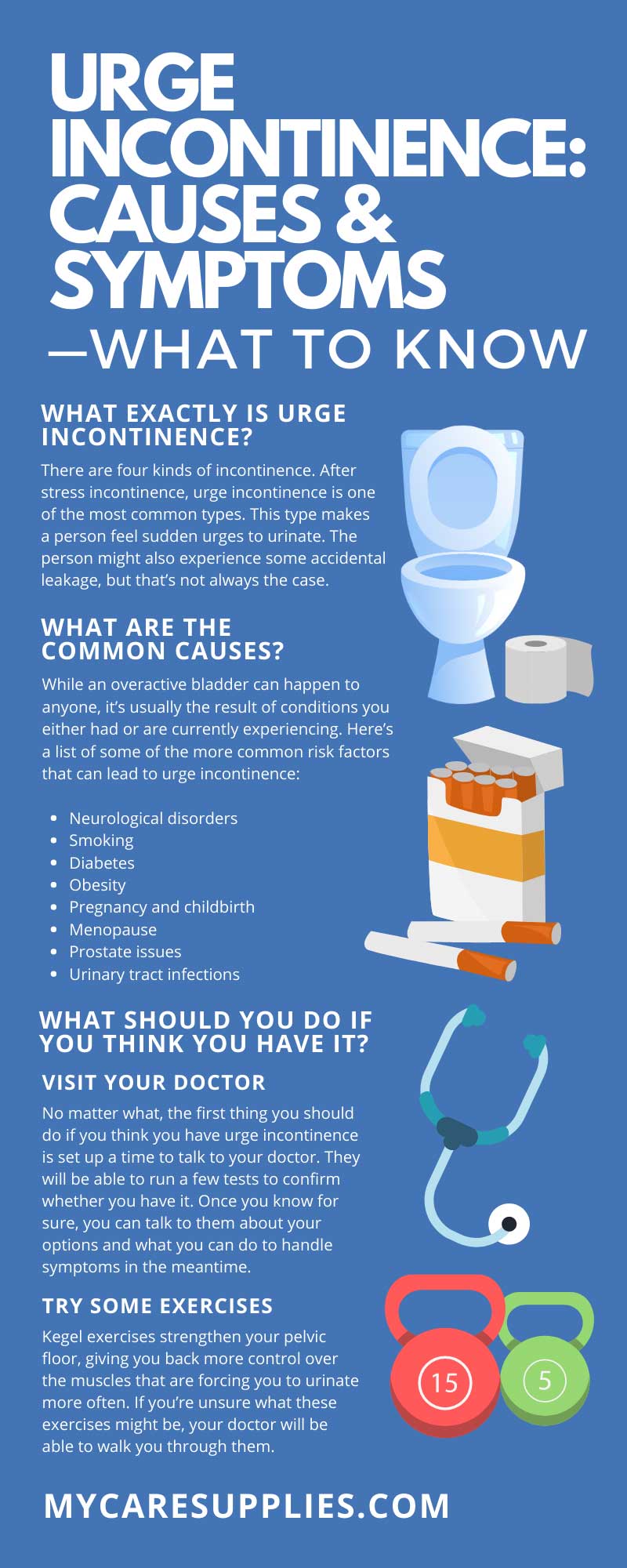Urge Incontinence: Causes & Symptoms—What To Know
Posted by Jeanne Lowry on May 15th 2023

While there is a lot of misunderstanding around incontinence and what it entails, a large percentage of people will experience it in some way, especially urge incontinence. In fact, about 40 percent of females and 30 percent of males will experience urge incontinence at some point in their lifetime.
However, this isn’t something you need to worry about. Urge incontinence is very manageable and, in most cases, completely reversible. But to ensure you deal with it appropriately if it ever comes up in your life, you need to know the causes and symptoms of urge incontinence. Once you understand those, you can take the steps to overcome the condition.
What Exactly Is Urge Incontinence?
There are four kinds of incontinence. After stress incontinence, urge incontinence is one of the most common types. This type makes a person feel sudden urges to urinate. The person might also experience some accidental leakage, but that’s not always the case.
People with urge incontinence tend to make bathroom trips more than eight times a day, as well as a couple of trips at night. Understandably, this can be quite an annoying problem to deal with.
What Are the Common Causes?
To better understand urge incontinence, we first need to know what can cause it. Most of the time, this condition stems from an overactive bladder. This issue occurs when your body forces muscles to squeeze your bladder, causing it to contract more often than it naturally should. This is what will cause you to feel the need to urinate. During this process, the sphincter muscles in your urethra relax, potentially causing accidental leakage on the way to the bathroom.
While an overactive bladder can happen to anyone, it’s usually the result of conditions you either had or are currently experiencing. Here’s a list of some of the more common risk factors that can lead to urge incontinence:
- Neurological disorders
- Smoking
- Diabetes
- Obesity
- Pregnancy and childbirth
- Menopause
- Prostate issues
- Urinary tract infections
Also, certain medications—like antidepressants, diuretics, and blood pressure medicine—can cause urge incontinence as a side effect, so be aware of that if taking them. We would like to note that none of these risk factors always lead to urge incontinence. It’s just possible to experience it at some point due to them.
What Symptoms Should You Watch For?
While most of the symptoms of urge incontinence will be pretty obvious to those who experience them, we still wanted to cover each of them.
The main symptom to watch out for is increased urination frequency. As we previously mentioned, urinating more than eight times a day is typically too much, especially if it’s consistent. Going at least twice at night is also an issue, but you should take it more seriously if you wake up specifically to go to the bathroom.
Also, if you experience any leakage while on the way to the bathroom, this could be another sign of urge incontinence. If you experience a couple of drops here or there, this isn’t something to be worried about, but you should make note of it. More importantly, if you ever experience bed-wetting, it could be a more significant sign of urge incontinence.
No matter which of these symptoms you may experience, it’s vital to know that urge incontinence isn’t always an instant thing. It can sometimes build up over a long period. This will make it harder to notice, so try to keep track of how often you feel the need to urinate if you suspect anything.
What Should You Do if You Think You Have It?
Now that you better understand the causes and symptoms of urge incontinence, you probably want to know what you should do about it. In this section, we’ll go through the step-by-step process you should follow if you suspect you have urge incontinence.
Visit Your Doctor
No matter what, the first thing you should do if you think you have urge incontinence is set up a time to talk to your doctor. They will be able to run a few tests to confirm whether you have it. Once you know for sure, you can talk to them about your options and what you can do to handle symptoms in the meantime.
Depending on the severity, your doctor might recommend some medications or suggest you buy yourself some incontinence care supplies. They’ll let you know which products will be best for you and help you regain control over any leakage you might be experiencing.
Try Some Exercises
In general, exercising is a great way to fight your urge incontinence since obesity can be a leading cause of the issue. However, to target incontinence more directly, you should focus on Kegel exercises.
Kegel exercises strengthen your pelvic floor, giving you back more control over the muscles that are forcing you to urinate more often. If you’re unsure what these exercises might be, your doctor will be able to walk you through them.
Schedule Your Bathroom Trips
Another way to strengthen your bladder muscles is to force yourself to avoid going to the bathroom as often. Obviously, you won’t want to immediately limit yourself to a few times a day. But you should create a schedule to gradually increase the time between each scheduled trip.
This is what’s known as bladder training. As your bladder gets used to waiting more often, the muscles that hold back your urine will become stronger, making it easier to wait longer.
Avoid Certain Triggers
Since an overactive bladder is the primary cause of urge incontinence, avoid certain triggers that can make you need to urinate more often. Of course, this doesn’t include drinking a healthy amount of water each day.
Instead, avoid drinks that have caffeine or alcohol in them. Also, you should stay away from any foods or drinks that are spicy or citrusy. If you smoke, talk to your doctor about finding ways to slow down and eventually stop, as smoking can also worsen your symptoms.
Look Into Further Treatments
If none of these methods have worked for you, not all hope is lost. You can still talk to your doctor about further treatments. In some cases, Botox injections can help relax the bladder, allowing it to hold more urine before voiding itself. Nerve stimulation implants can also work to relax an overactive bladder.
Finally, if there is a deeper problem with your bladder, a urostomy might be best. This step is rarely necessary, but it acts as a good last-case option for individuals searching for relief. Ultimately, it’s reassuring to know you can always do something to handle your urge incontinence.


